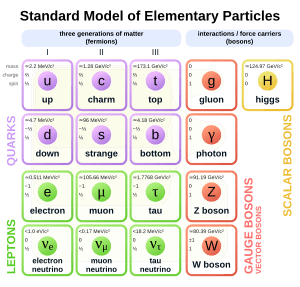Quark facts for kids

A quark is a super tiny particle. It is one of the basic building blocks of matter. Quarks make up bigger particles like protons and neutrons. Protons and neutrons are found inside the center of every atom.
For a long time, scientists thought that protons, neutrons, and electrons were the smallest particles. They believed these could not be broken down further. But with new tools like particle accelerators, they found out that protons and neutrons are actually made of even smaller things: quarks! Electrons, however, are still considered fundamental particles. Quarks inside protons and neutrons are held together by other particles called gluons.
Contents
Discover the Six Types of Quarks
There are six different types of quarks. Scientists call these types flavors. Each flavor has unique properties.
Exploring Quark Flavors and Their Charges
The six quark flavors are:
Quarks have an electric charge. Up, charm, and top quarks have a charge of +2⁄3. Down, strange, and bottom quarks have a charge of -1⁄3.
Meet the Antiquarks
Every quark has a matching antiquark. An antiquark is like a quark's opposite twin. Antiquarks have the opposite charge of their quark partners. For example, an up antiquark has a charge of -2⁄3. A down antiquark has a charge of +1⁄3.
Quarks in Everyday Matter
Only two types of quarks are common in the world around us. These are the up and down quarks. They form the protons and neutrons in all normal matter.
How Quarks Build Protons and Neutrons
- A proton is made of two up quarks and one down quark.
* (Charge: +2⁄3 + +2⁄3 - 1⁄3 = +1)
- A neutron is made of one up quark and two down quarks.
* (Charge: +2⁄3 - 1⁄3 - 1⁄3 = 0)
The other four quark flavors (strange, charm, top, and bottom) are not usually found on Earth. Scientists can create them in powerful particle accelerators. These special quarks might also exist inside certain types of stars.
Understanding Hadrons: Particles Made of Quarks
When two or more quarks are held together, they form a new particle called a hadron. The force that holds them together is called the strong nuclear force.
Two Main Families of Hadrons
Hadrons come in two main families:
- Baryons are made of three quarks. Protons and neutrons are examples of baryons.
- Mesons are made from one quark and one antiquark.

Why Quarks Stick Together
Quarks are very hard to separate. The force holding them together actually gets stronger the farther apart they are pulled. It's like a super strong rubber band! If you try to pull them too far apart, the energy you use is so great that it creates new quarks. This means quarks are never found alone. They always exist in groups, forming hadrons.
The Discovery of Quarks
The idea of quarks was first suggested by two physicists. They were Murray Gell-Mann and George Zweig. This happened in 1964. Other scientists then started looking for proof that quarks really existed. They found strong evidence for quarks in 1968.
Images for kids
-
Photograph of the event that led to the discovery of the Error no symbol defined baryon, at the Brookhaven National Laboratory in 1974
See also
 In Spanish: Cuark para niños
In Spanish: Cuark para niños




